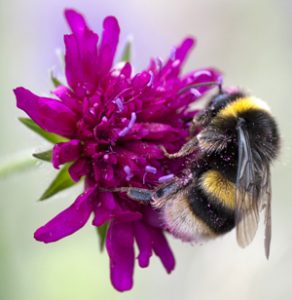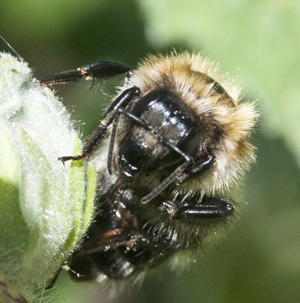Bumblebee survival

The warmth of recent days has seen bumblebee queens foraging among the Spring flowers. They have emerged from hibernation. They now need to feed and then find a place to create a nest. The queen will then lay eggs, which will become ‘daughter workers’. Later in the season, males and new queens hatch - they will leave the nest / colony. The new queens that are fertilised will hibernate after they have fed (heavily hopefully) on nectar and pollen from available flowers.
Researchers at the Centre for Ecology and Hydrology, the University of East Anglia, the Zoological Society of London and University College London, have been studying different generations of three species of bumblebee (Bombus terrestris, the buff-tailed bumblebee; Bombus lapidarius, the red-tailed bumblebee and Bombus pascuorum, the common carder bee) in a farmland area.
They have been able to show, through DNA techology and remote sensing, that the ‘quality’ of the habitats close to the nest / colony affects the survival of the queen and her descendants. By tracking mother, daughter and sister bumblebees over two years - they discovered that the colonies / nests produced more daughter queens that lived to the following year when the colonies were located near habitats with high-quality food resources (that is, within 250-1,000 metres of the resource). Such resources include spring and summer-flowering plants that can provide pollen and nectar throughout the bees’ lifecycle.
 Dr Carvell (Senior Ecologist at CEH) said “The findings suggest that increasing flowers provided by spring-flowering trees, hedgerow plants and crops across the landscape – in combination with summer flower resources along field edges – can increase the probability of family survival by up to four times,”.
Dr Carvell (Senior Ecologist at CEH) said “The findings suggest that increasing flowers provided by spring-flowering trees, hedgerow plants and crops across the landscape – in combination with summer flower resources along field edges – can increase the probability of family survival by up to four times,”.
The results support the management of farmland in an environmentally-friendly manner to provide more flowers along the edges of arable fields, and the maintenance of hedgerows & meadows as further wild flower resources. Spring flowering trees like willow, and flowers such as common yarrow, greater knapweed and foxgloves are important sources of food for bumblebees, but so are the flowers to be found in urban gardens. Bumblebees are vital insect pollinators of many crops - but they are suffering a world wide decline in numbers; so anything that promotes the viability of colonies is to be encouraged.
Comments are closed for this post.
Discussion
That’s why I’ve been letting the grass grow and scything it in the Autumn for years now – at first you get dandelions and daisies, buttercups then red and white clover and, after 3 years we got native Orchids…..just a few at first but last year we had 60 of 4 different species; of course not everyone understands and you get some strange looks but it’s about allowing what nature needs, not removing it to look tidy for humans.

iI have seen quite a few very large black bumble bees in my garden, in Cardiff. I grow some early flowering species particularly perrenial wallflowers which flower continuously throughout the year. I have also noticed that many flying insects love the blossom of mint if allowed to flower.
How can I encourage bumble bees to nest in my garden?
Thank you.
Regards,
Suzanne.
SUZANNE KOBER
26 April, 2017